ISSN ONLINE(2319-8753)PRINT(2347-6710)
ISSN ONLINE(2319-8753)PRINT(2347-6710)
Pardeep Singh1, Harvinder lal2, Baljit Singh Ubhi3
|
| Related article at Pubmed, Scholar Google |
Visit for more related articles at International Journal of Innovative Research in Science, Engineering and Technology
In this research, the heat transfer performance of fin is analyzed by design of fin with various extensions such as rectangular extension, trapezium extension, triangular extensions and circular segmental extensions. The heat transfer performance of fin with same geometry having various extensions and without extensions is compared. Near about ranging 5% to 13% more heat transfer can be achieved with these various extensions on fin as compare to same geometry of fin without these extensions. Fin with various extensions design with the help of software AutoCAD. Analysis of fin performance done through the software Autodesk® Simulation Multiphysics. In this thermal analysis, temperature variations w.r.t. distance at which heat flow occur through the fin is analyzed. Extensions on the finned surfaces is used to increases the surface area of the fin in contact with the fluid flowing around it. So, as the surface area increase the more fluid contact to increase the rate of heat transfers from the base surface as compare to fin without the extensions provided to it. On comparison, rectangular extensions provide on fin gives the greatest heat transfer than that of other extensions having the same length and width attached to finned surface. The effectiveness of fin with rectangular extensions greater as compare to other extensions on fin.
Keywords |
| Extended surface, Analysis, Extensions, Design and Heat transfer enhancement. |
INTRODUCTION |
| A fin is a surface that extends from an object to increase the rate of heat transfer to or from the environment by increasing convection. Extensions on the finned surfaces is used to increases the surface area of the fin in contact with the fluid flowing around it. So, as the surface area increase the more fluid contact to increase the rate of heat transfers from the base surface as compare to fin without the extensions provided to it. Types of extension provided on fin such as (a) Rectangular extensions, (b) Trapezium extensions, (c) Triangular extension, and (d) Circular Segmental extension. |
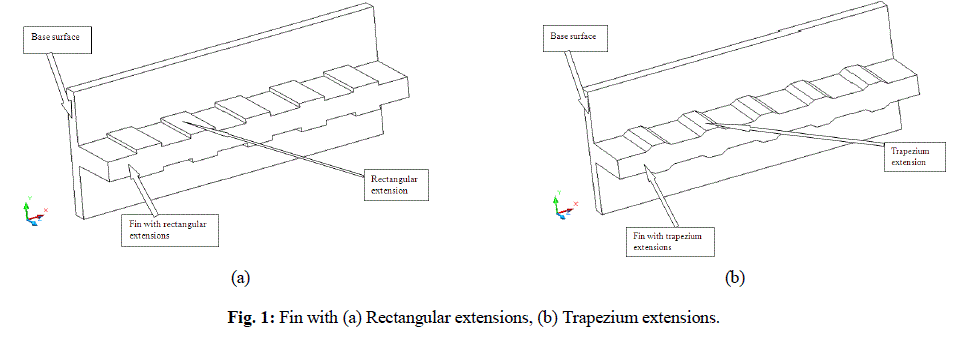 |
 |
LITERATURE REVIEW |
| Abdullah, H. Alessa et. al. [1] had studied the natural convection heat transfer enhancement from a horizontal rectangular fin embedded with equilateral triangular perforations. The heat dissipation rate from the perforated fin is compared to that of the equivalent solid one. The effect of geometrical dimensions of the perforated fin and thermal properties of the fin was studied in detail. They concluded that, For certain values of triangular dimensions, the perforated fin can result in heat transfer enhancement. The magnitude of enhancement is proportional to the fin thickness and its thermal conductivity. The perforation of fins enhances heat dissipation rates and at the same time decreases the expenditure of the fin material. B. Ramdas Pradip et. al. [2] had studied the many industries are utilizing thermal systems wherein overheating can damage the system components and lead to failure of the system. In order to overcome this problem, thermal systems with effective emitters such as ribs, fins, baffles etc. are desirable. The need to increase the thermal performance of the systems, thereby affecting energy, material and cost savings has led to development and use of many techniques termed as “Heat transfer Augmentation”. This technique is also termed as “Heat transfer Enhancement” or “Intensification”. Augmentation techniques increase convective heat transfer by reducing the thermal resistance in a heat exchanger. Many heat augmentation techniques has been reviewed, these are (a) surface roughness, (b) plate baffle and wave baffle, (c) perforated baffle, (d) inclined baffle, (e) porous baffle, (f) corrugated channel, (g) twisted tape inserts, (h) discontinuous Crossed Ribs and Grooves. Most of these enhancement techniques are based on the baffle arrangement. Use of Heat transfer enhancement techniques lead to increase in heat transfer coefficient but at the cost of increase in pressure drop. Golnoosh Mostafavi [3] had investigated the steady-state external natural convection heat transfer from verticallymounted rectangular interrupted finned heatsinks. After regenerating and validating the existing analytical results for continuous fins, a systematic numerical, experimental, and analytical study is conducted on the effect of the fin array and single wall interruption. FLUENT and COMSOL Multiphysics software are used in order to develop a twodimensional numerical model for investigation of fin interruption effects. Results show that adding interruptions to vertical rectangular fins enhances the thermal performance of fins and reduces the weight of the fin arrays, which in turn, can lead to lower manufacturing costs. |
| Sable, M.J. et. al. [4] had investigated for natural convection adjacent to a vertical heated plate with a multiple v- type partition plates (fins) in ambient air surrounding. As compared to conventional vertical fins, this v-type partition plate’s works not only as extended surface but also as flow turbulator. In order to enhance the heat transfer, V-shaped partition plates (fins) with edges faced upstream were attached to the two identical vertical plates. They observed that among the three different fin array configurations on vertical heated plate, V-type fin array design performs better than rectangular vertical fin array and V-fin array with bottom spacing design. The performance was observed to improve further, with increase in the height of the V-plates (fin height). |
DESIGN AND ANALYSIS OF FIN WITH EXTENSIONS |
| A. Designing of Fin with AutoCAD |
| The fin with various extensions are design with the help of design software AutoCAD by using the AutoCAD 2D and 3D commands like as 2D commands polyline, arc, mirror , pedit ,& 3D commands extrude. The line draws with the Polar mode. In this mode length of the line and angle of the line is defined to draw the design. [5] The angle is measured in anti-clock direction starting from the first quadrant. Main Fin specifications: Length, l = 40mm = 0.04 m, width, b = 240 mm = 0.24 m and thickness, y = 15mm = 0.015 m. Specifications of various extensions shown in the Fig. 3 and number of extensions used on main fin is 10 nos. |
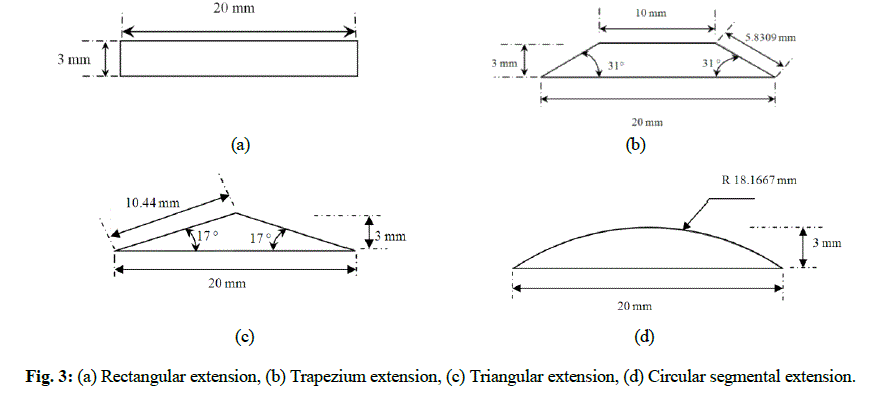 |
| B. Analysis of Fin for Heat Transfer with Simulation Software |
| After the creation of design the next process is to analysis the fin for heat transfer by using software Autodesk® Simulation Multiphysics. Firstly import the design model AutoCAD DWG file (*.dwg) in the Autodesk® Simulation Multiphysics software this will make the result as Autodesk Simulation FEA model (*.fem) file format. Now, select the type of analysis as thermal analysis for steady-state heat transfer process. Assign unit system as customization length in mm, temperature in °C and thermal energy in J. Now from the 3D mesh setting set 60% mesh size towards fine. Generate the mesh of design. |
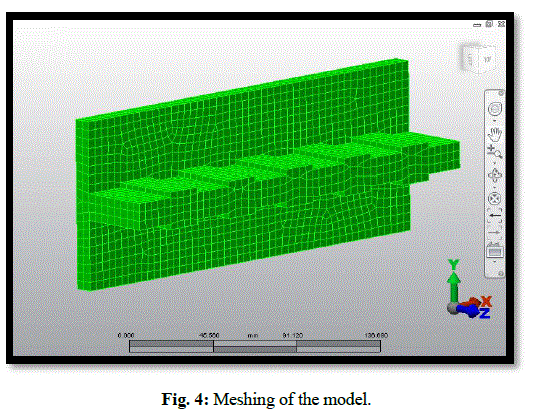 |
| Fig. 4 shows that meshing of the model. The meshing result shows that the solid mesh surface part having 3310 elements created, final mesh size is 4.75669 mm and surface mesh contain 3305 nodes, 9909 lines. The mesh type is mix of brick, wedges, pyramids and tetrahedra. |
| C. Assigning Load and Constraints to the Meshed Model |
| In this assign the material having thermal conductivity, convection coefficient of heat transfer for fluid, temperature of surface and ambient temperature as: Thermal conductivity, k = 40 W/m °C = 0.04 J/(s mm °C) Convection coefficient of heat transfer, h = 40 W/m2 °C = 0.00004 J/(s mm2 °C) Temperature of wall surface at which fin attached, to = 55 °C Ambient temperature, ta = 30 °C |
| D. Results from the Analysis |
| After the generation of mesh and assigning of load and constraints next step is to run the simulation for the model. This proceeds for the analyzing the steady-state heat transfer process and finally obtain the required result contour of temperature. |
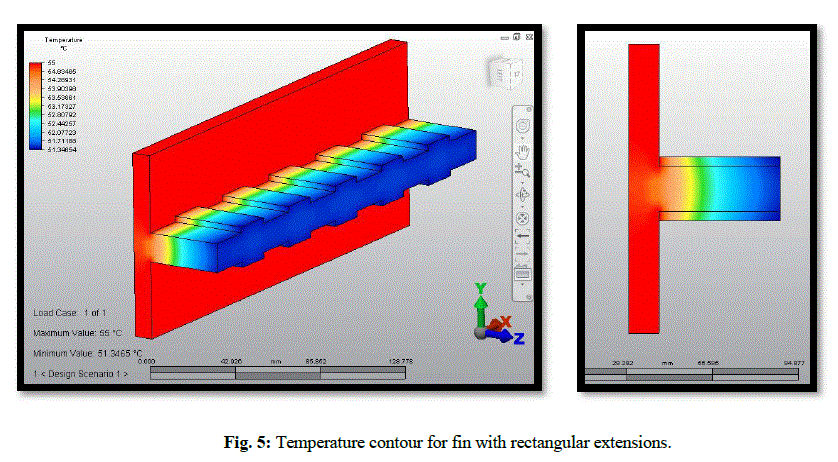 |
| The resultant Fig. 5 shows that variations of temperature along length of fin with rectangular extensions that the temperature reduces from fin base at 55 °C to 51.3465 °C at the tip end of the fin. |
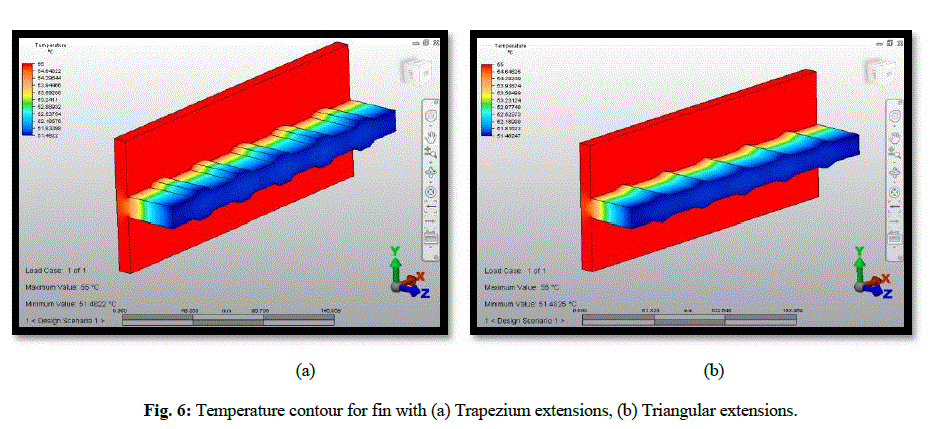 |
| Similarly the resultant Fig. 6 & Fig. 7 shows that variations of temperature along length of fin with trapezium extensions, triangular extensions and fin with circular segmental extensions, fin without extensions that the temperature reduces from fin base to the tip end of the fin. |
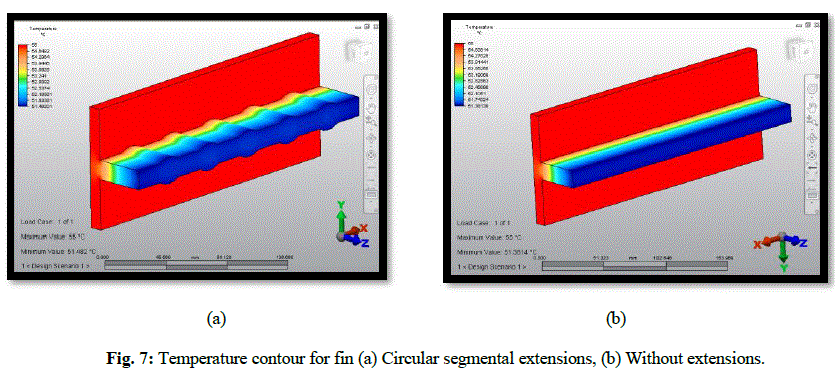 |
| The Table-1 shows that comparison of temperatures of fin with different types of extensions corresponding to the length of fins. |
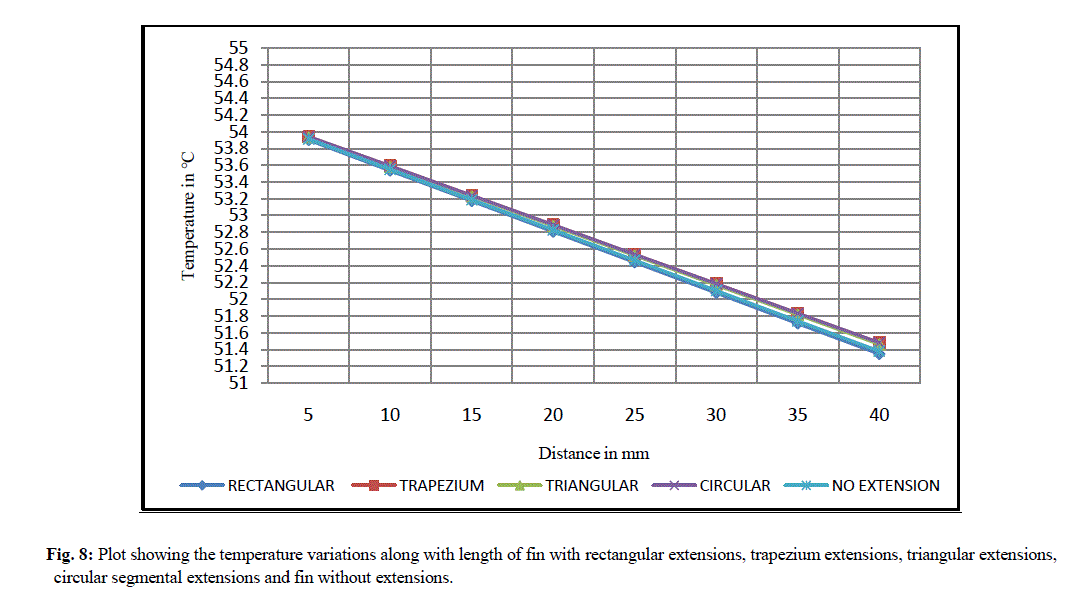 |
| Fig. 8: Plot showing the temperature variations along with length of fin with rectangular extensions, trapezium extensions, triangular extensions, circular segmental extensions and fin without extensions. |
RESULTS AND DISCUSSIONS |
| Heat transfer calculated by using the heat transfer governing differential equation for the fin of finite length and loses heat by convection [6], |
 |
| for which the given length of fin (l in m), thickness of fin (y in m), width of fin (b in m),thermal conductivity of fin (k in W/m °C ), coefficient of convective heat transfer (h in W/m2 °C ) , temperature at base of fin (to in °C),temperature of the ambient fluid (ta in °C). After the calculations of heat transfer rate of various fin geometry now it is the time to compare the increase in heat transfer rate for the given geometry of fin which is shown in Table-2. The fin without extensions having 21.7665 W heat transfer value. |
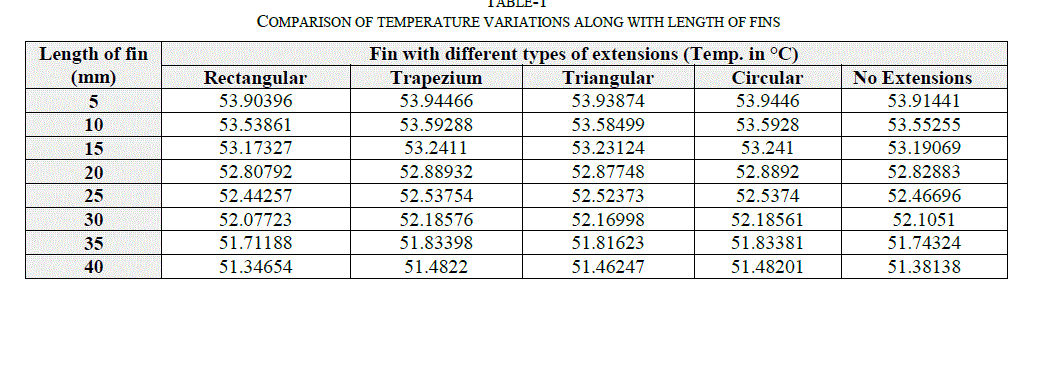 |
| Now, for the discussions the heat transfer through fin with different extensions calculated by considering the changes in ambient fluid temperature from 28 °C to 18 °C as shown in the Table-3. |
 |
| The use of fin with different extensions provides the increase in the heat transfer rate as compare to fin without extensions shown in the Table-4. |
 |
 |
CONCLUSIONS |
| The use of fin (extended surface) with extensions, provide efficient heat transfer: |
| Fin with extensions provide near about 5 % to 13% more enhancement of heat transfer as compare to fin without extensions. |
| Heat transfer through fin with rectangular extensions higher than that of fin with other types of extensions. |
| Temperature at the end of fin with rectangular extensions is minimum as compare to fin with other types of extensions. |
| The effectiveness of fin with rectangular extensions is greater than other extensions. |
| Choosing the minimum value of ambient fluid temperature provide the greater heat transfer rate enhancement. |
References |
|